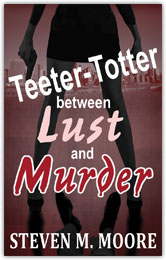Revealing clues…
I started writing mysteries long ago with the Dr. Carlos stories. Carlos Obregon is chief medical officer on a starship in the future. (See the list of free PDF downloads on the “Free Stuff & Contests” web page.) He was inspired by Isaac Asimov’s Elijah Bailey, a detective from planet Earth who solved crimes in Asimov’s robot trilogy. In other words, my Dr. Carlos stories are sci-fi mysteries, an unusual cross-genre experiment lacking a bit of originality.
It took awhile, but NYPD detective Castilblanco soon came on the scene. His cases covered eight novels and several works of short fiction. (His adopted son and daughter followed in the old man’s footsteps.)
More recently, Esther Brookstone and Steve Morgan added a bit of British flavor to my storytelling (novels and more works of short fiction). I learned about crimefighting in the UK and on the European continent. (I’m sure some European readers, especially those in the UK, have found some mistakes. They weren’t intentional.)
Along this long trajectory, I’ve been bothered by one question above all: What clues should a mystery/crime writer reveal to keep the reader interested? That question includes number and source, of course. In the literature, there’s a wide spectrum of answers. There are apparently two extremes: Garcia Marquez reveals all at the beginning of Chronicle of A Death Foretold; in Asimov’s Robots of Dawn, an intricate and out-of-this-world mystery compared to the first two novels of his trilogy (Asimov was expanding his horizons, I suppose), clues are discovered one by one until the murderer is discovered, more a la Agatha Christie.
A technique I saw used in one British-style mystery I read (I’ve binged on entire series, which began as a way to deal with the isolation from Covid) is to include a section in each chapter where the actions of the murderer are portrayed, but the reader doesn’t know whom among the people interviewed by the detectives corresponds to the unnamed murderer. Effective, I thought, but it seemed to be a bit of a swindle.
The answers to that question raised above are probably as numerous as the the number of mystery writers. In mystery/crime stories, I’m also all over the board. The danger of revealing too much is that can turn a mystery story into a thriller. (All my thrillers have mystery elements; most do.)
The answers are best determined by flow, to be honest, which must mostly carry the reader forward in the plot. In the two examples indicated above, the flow is completely different. Garcia-Marquez’s is actually “backward flow.” Asimov’s reminds me of why we all many UK mysteries to be about “plods”: Elijah Bailey is a “plod”!
In my stories, I’ll have to admit that I don’t have a single answer to that all-important question. I have to confess that every story takes me to a slightly different one. I suppose that’s not unusual: Each mystery is different albeit variations on a theme (or themes), so the answers must be different.
I also suppose that some readers might like to know which story of mine has the most twists (these represent how the answers to the question vary). That’s easy to answer. While all my mysteries are different, from other authors’ and between novels even in the same series, Teeter-Totter between Lust and Murder is probably the novel that has the most clues and leaves the reader guessing until the end. That case was a real challenge for Detective Castilblanco.
***
 Comments are always welcome. (Please follow the rules on the “Join the Conversation” web page.)
Comments are always welcome. (Please follow the rules on the “Join the Conversation” web page.)
Teeter-Totter between Lust and Murder. This was my very first mystery novel and maybe one of the best. It’s “evergreen” in the sense it’s still very relevant today. Although Detective Chen plays a supporting role in the “Detectives Chen and Castilblanco” series, it’s a major one in most of the novels. As a strong-willed true conservative from Long Island, she has relationship problems. The story begins here when her relationship with a US senator goes terribly wrong and the politician is murdered. As Castilblanco tries to clear his partner, an arms trafficking scheme and plot to seize power are uncovered. Have a great time following the many clue to the surprising end (and perhaps unexpected, as one reviewer noted).
Around the world and to the stars! In libris libertas!
